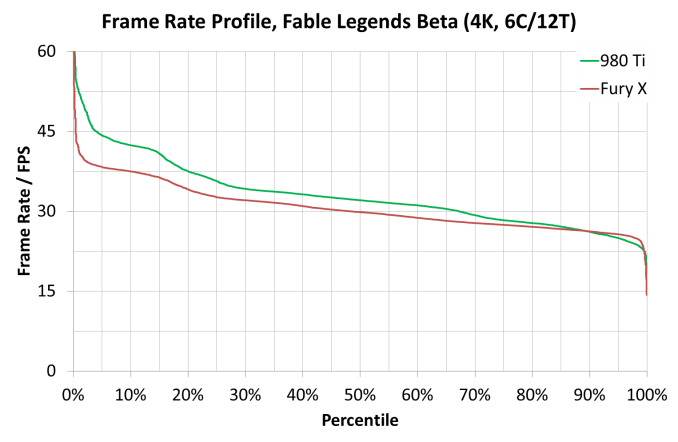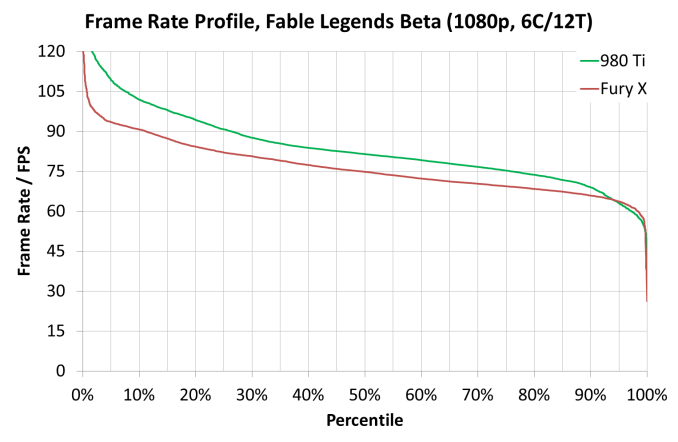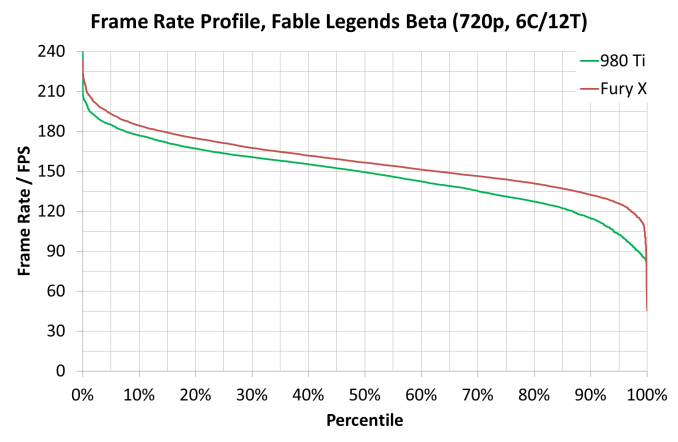Fable Legends Early Preview: DirectX 12 Benchmark Analysis
by Ryan Smith, Ian Cutress & Daniel Williams on September 24, 2015 9:00 AM ESTComparing Percentile Numbers Between the GTX 980 Ti and Fury X
As the two top end cards from both graphics silicon manufacturers were released this year, there was all a big buzz about which is best for what. Ryan’s extensive review of the Fury X put the two cards head to head on a variety of contests. For DirectX 12, the situation is a little less clear cut for a number of reasons – games are yet to mature, drivers are also still in the development stage, and both sides competing here are having to rethink their strategies when it comes to game engine integration and the benefits that might provide. Up until this point DX12 contests have either been synthetic or having some controversial issues. So for Fable Legends, we did some extra percentile based analysis for NVIDIA vs. AMD at the top end.
For this set of benchmarks we ran our 1080p Ultra test with any adaptive frame rate technology enabled and recorded the result:
For these tests, usual rules apply – GTX 980 and Fury X, in our Core i7/i5/i3 configurations at all three resolution/setting combinations (3840x2160 Ultra, 1920x1080 Ultra and 1280x720 Low). Data is given in the form of frame rate profile graphs, similar to those on the last page.
As always, Fable Legends is still in early access preview mode and these results may not be indicative of the final version, but at this point they still provide an interesting comparison.
At 3840x2160, both frame rate profiles from each card looks the same no matter the processor used (one could argue that the Fury X is mildly ahead on the i3 at low frame rates), but the 980 Ti has a consistent gap across most of the profile range.
At 1920x1080, the Core i7 model gives a healthy boost to the GTX 980 Ti in high frame rate scenarios, though this seems to be accompanied by an extended drop off region in high frame rate areas. It is also interesting that in the Core i3 mode, the Fury X results jump up and match the GTX 980 Ti almost across the entire range. This again points to some of the data we saw on the previous page – at 1080p somehow having fewer cores gave the results a boost due to lighting scenarios.
At 1280x720, as we saw in the initial GPU comparison page on average frame rates, the Fury X has the upper hand here in all system configurations. Two other obvious points are noticeable here – moving from the Core i5 to the Core i7, especially on the GTX 980 Ti, makes the easy frames go quicker and the harder frames take longer, but also when we move to the Core i3, performance across the board drops like a stone, indicating a CPU limited environment. This is despite the fact that with these cards, 1280x720 at low settings is unlikely to be used anyway.













141 Comments
View All Comments
tackle70 - Thursday, September 24, 2015 - link
Nice article. Maybe tech forums can now stop with the "AMD will be vastly superior to Nvidia in DX12" nonsense.cmdrdredd - Thursday, September 24, 2015 - link
Leads me to believe more and more that Stardock is up to shenanigans just a bit or that not every game will use certain features that DX12 can perform and Nvidia is not held back in those games.Jtaylor1986 - Thursday, September 24, 2015 - link
I'd say Ashes is a far more representative benchmark. What is the point of doing a landscape simulator benchmark. This demo isn't even trying to replicate real world performancecmdrdredd - Thursday, September 24, 2015 - link
Are you nuts or what? This is a benchmark of the game engine used for Fable Legends. It's as good a benchmark as any when trying to determine performance in a specific game engine.Jtaylor1986 - Thursday, September 24, 2015 - link
Except its completely unrepresentative of actual gameplay unless this grass growing simulator.Jtaylor1986 - Thursday, September 24, 2015 - link
"The benchmark provided is more of a graphics showpiece than a representation of the gameplay, in order to show off the capabilities of the engine and the DX12 implementation. Unfortunately we didn't get to see any gameplay in this benchmark as a result, which would seem to focus more on combat."LukaP - Thursday, September 24, 2015 - link
You dont need gameplay in a benchmark. you need the benchmark to display common geometry, lighting, effects and physics of an engine/backend that drives certain games. And this benchmark does that. If you want to see gameplay, there are many terrific youtubers who focus on that, namely Markiplier, NerdCubed, TotalBiscuit and othersMr Perfect - Thursday, September 24, 2015 - link
Actual gameplay is still important in benchmarking, mainly because that's when framerates usually tank. An empty level can get fantastic FPS, but drop a dozen players having an intense fight into that level and performance goes to hell pretty fast. That's the situation where we hope to see DX12 outshine DX11.Stuka87 - Thursday, September 24, 2015 - link
Wrong, a benchmark without gameplay is worthless. Look at Battlefield 4 as an example. Its built in benchmarks are worthless. Once you join a 64 player server, everything changes.This benchmark shows how a raw engine runs, but is not indicative of how the game will run at all.
Plus its super early in development with drivers that stil need work, which the article states that AMD's driver arrived too late.
inighthawki - Thursday, September 24, 2015 - link
Yes, but when the goal is to show improvements in rendering performance, throwing someone into a 64 player match completely skews the results. The CPU overhead of handling a 64 player multiplayer match will far outweigh to small changes in CPU overhead from a new rendering API.